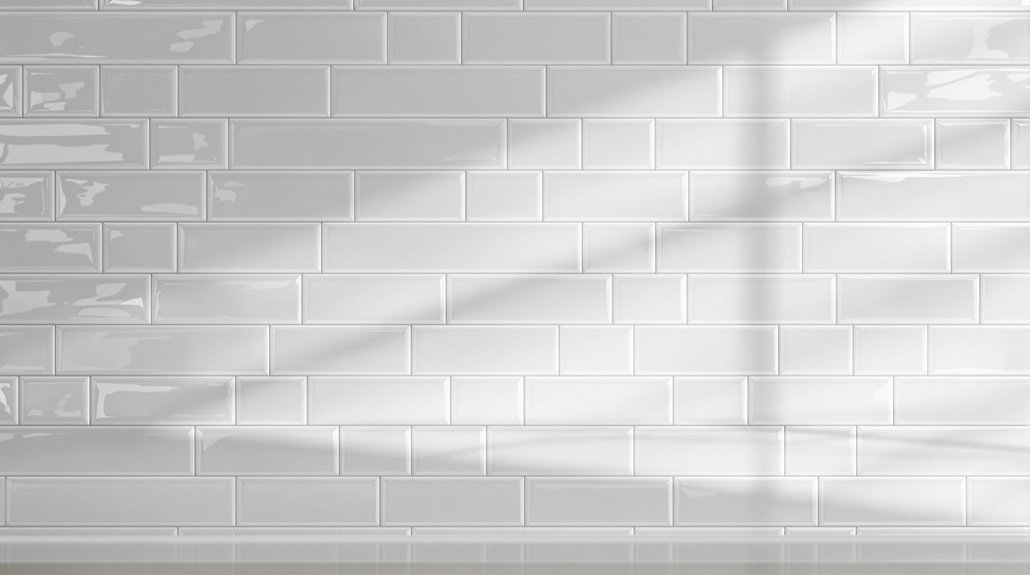
16 White Kitchen Wall Tile Ideas That Feel Clean and Timeless
White kitchen wall tile ideas balance timeless appeal with modern function. Classic subway tiles, herringbone patterns, and textured matte finishes deliver sophistication and light enhancement. Hexagonal or penny tiles introduce artistic geometry, while floor-to-ceiling installations raise vertical space. Contrasting grout provides graphic definition, and subtle square or rustic tiles create minimalist or cozy ambiances. Glossy surfaces and marble-effect options amplify brightness. Paired with neutral cabinetry, these tiles embody enduring style. Discover more distinct concepts and transformative layout solutions.
Key Takeaways
- Classic white subway tiles with contrasting grout create a bright, timeless kitchen look and emphasize geometric patterns like herringbone or stacked layouts.
- Matte white tiles offer a modern, minimalist style while hiding fingerprints and pairing well with natural materials for added warmth.
- Marble-effect tiles provide a luxurious yet low-maintenance alternative, seamlessly fitting both traditional and contemporary kitchen designs.
- Textured and Zellige-style white tiles introduce visual depth and artisanal character, making backsplashes feel sophisticated and unique.
- Floor-to-ceiling white tile feature walls maximize light and height, giving kitchens an airy, expansive, and cohesive appearance.
Classic Subway Tiles for a Sleek Look
Whether incorporated into a traditional or contemporary kitchen, classic subway tiles—typically sized at 3×6 inches—deliver a clean, timeless aesthetic prized for its versatility.
White metro tiles in a glossy white finish maximize ambient light, making spaces appear brighter and more expansive. Their reflective surfaces contribute to a polished, sophisticated environment.
Glossy white metro tiles amplify light and create a spacious, refined atmosphere, elevating any kitchen with their luminous, polished finish.
Designers frequently leverage pattern variability, such as herringbone or stacked layouts, to introduce visual intrigue without sacrificing cohesion. The adaptability of glossy white metro tiles allows effortless pairing with diverse cabinetry hues and surface textures, ensuring seamless integration into evolving design schemes.
Pairing white cabinets with black countertops creates a bold contrast that enhances the perception of space and openness, contributing to the timeless appeal of classic subway tiles.
Employing contrasting grout—such as black or grey—further accentuates the geometric clarity of the tiles, imparting depth and definition. This strategic approach enhances the kitchen’s visual impact while maintaining enduring, functional appeal.
Matte White Tiles for Subtle Sophistication
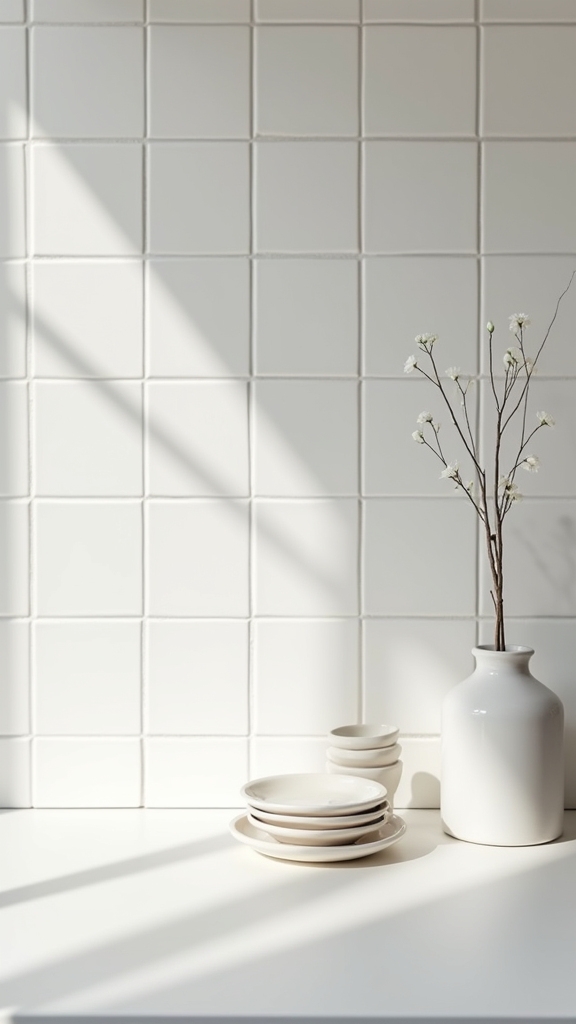
Matte white tiles introduce a contemporary minimalist appeal, offering a refined alternative to high-gloss surfaces.
Their subtle finish enhances texture and depth, lending visual interest without overpowering the kitchen’s overall scheme.
This choice creates a sophisticated foundation that supports both functional and aesthetic objectives in modern kitchen design.
Contemporary Minimalist Appeal
By favoring a soft, non-reflective finish, matte white tiles introduce understated sophistication to contemporary kitchens rooted in minimalist design principles.
On a white kitchen wall, matte white tiles provide a streamlined visual continuity that aligns with the ethos of simplicity and uncluttered space. Their velvety surface absorbs light, reducing glare and reinforcing a serene, airy environment.
This finish also conceals water spots and fingerprints, supporting a pristine appearance with minimal upkeep—ideal for high-traffic kitchens.
The versatility of matte white tiles allows seamless pairing with natural materials, such as timber cabinetry or stone countertops, without compromising the overall minimalist vision.
Utilizing contrasting grout lines further articulates the tile pattern, adding subtle graphic interest while preserving the space’s tranquil, cohesive aesthetic.
Enhanced Texture and Depth
While many kitchen designs aim for visual simplicity, the nuanced surface of matte white tiles introduces a refined layer of texture and depth without disrupting the space’s cohesion.
Matte white tiles, such as those from the Marlborough Matts collection, provide a soft, contemporary aesthetic while subtly elevating the room’s tactile quality. Unlike their glossy counterparts, matte finishes diffuse light, minimizing glare and enhancing visual interest through understated surface variation.
This material solution is inherently practical: it offers slip resistance—ideal for family kitchens—and is less prone to visible watermarks, ensuring lower maintenance and a consistently clean appearance.
When paired with contrasting grout, matte white tiles create distinctive lines, deepening the sense of dimensionality and reinforcing a timeless, yet sophisticated, kitchen environment.
Glossy Finishes to Brighten Small Spaces
Glossy white tiles serve as an effective solution for maximizing light in compact kitchen environments, their reflective surfaces amplifying natural and artificial illumination to create a sense of openness. In small kitchens, this material selection not only enhances spatial perception but also delivers a sleek, contemporary aesthetic. The ease of cleaning glossy finishes—requiring minimal effort to erase spills or smudges—proves advantageous in high-traffic culinary spaces. However, these tiles may reveal fingerprints or water spots more readily, necessitating routine maintenance. Integrating glossy white tiles with matte cabinetry or countertops introduces visual contrast, adding depth without overwhelming the limited footprint. For design professionals, the interplay of finish, light, and proportion can be strategically leveraged to achieve a timeless, light-filled environment. Large-format white tiles provide a seamless, luxurious look in kitchens, making spaces feel brighter and more spacious, which is ideal for contemporary designs seeking simplicity.
| Feature | Benefit | Consideration |
|---|---|---|
| Glossy Surface | Reflects light | Shows fingerprints |
| Easy Cleanability | Quick maintenance | Frequent wiping needed |
| Modern Aesthetic | Timeless appeal | May highlight marks |
| Visual Contrast | Adds depth | Pair with matte |
Chic Herringbone Patterns for Added Elegance

A well-executed herringbone pattern introduces architectural interest and refined movement to white kitchen wall tiles, elevating the overall visual narrative of the space.
Herringbone patterns are renowned for their dynamic visual impact, infusing depth and sophistication into kitchen environments. The linear arrangement not only amplifies the sense of space—particularly advantageous in more compact kitchens—but also guarantees the design remains timeless and adaptable across diverse interior aesthetics.
Glossy white kitchen tiles arranged in a herringbone layout maximize light reflection, yielding a luminous, airy backdrop. For those seeking to enhance elegance and spatial perception, consider the following:
- Enhances spatial dynamics and depth in smaller kitchens
- Seamlessly integrates with both modern and traditional design schemes
- Reflects light for a brighter, more inviting atmosphere
This solution balances both visual and functional demands. Incorporating metallic accents into the herringbone pattern can introduce an additional layer of shimmer and depth, elevating the kitchen’s ambiance with understated sophistication.
White Metro Tiles With Contrasting Grout
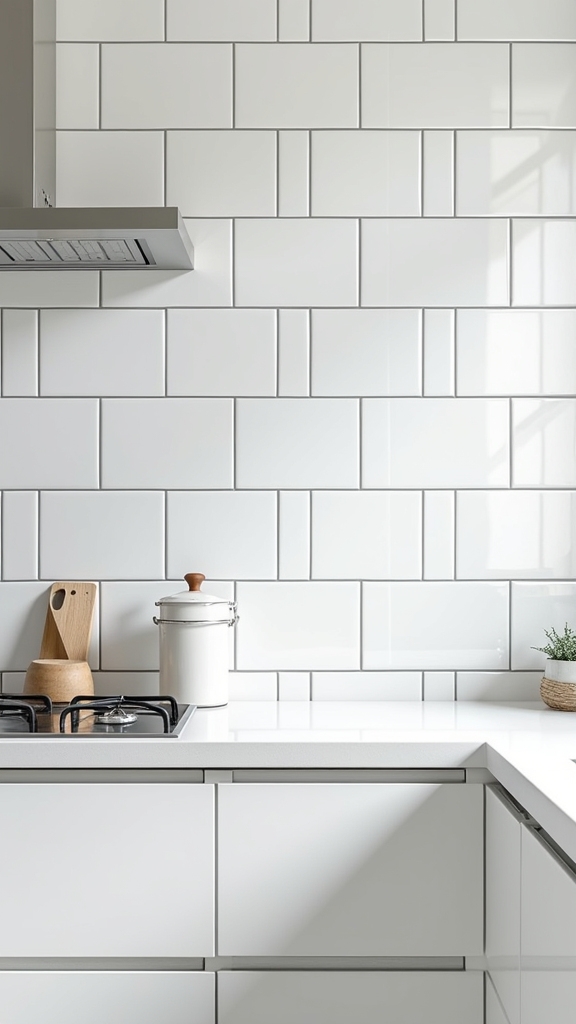
White metro tiles paired with contrasting grout deliver a distinct industrial chic visual impact, transforming simple surfaces into bold design statements.
Grout color customization offers precise control over the kitchen’s aesthetic, allowing for everything from subtle sophistication to dramatic contrast.
This approach also enhances tile definition, ensuring each tile’s geometry is clearly articulated for a crisp, contemporary finish.
Industrial Chic Visual Impact
Contrast forms the foundation of industrial chic when white metro tiles are paired with dark, contrasting grout. This juxtaposition is a hallmark of the industrial look, emphasizing the geometric precision of each tile and infusing the kitchen with textural depth.
The glossy surface of white metro tiles not only bounces light across the space, enhancing openness, but also reinforces clean, architectural lines. Integrating these elements achieves a sophisticated, urban aesthetic that remains timeless and versatile.
For those seeking to amplify the visual impact of their kitchen walls, consider:
- Arranging white metro tiles in a herringbone pattern for dynamic movement while preserving industrial order.
- Selecting black or medium grey grout to outline each tile’s crisp form, injecting modernity.
- Utilizing reflective finishes to make compact kitchens feel notably larger.
Grout Color Customization
Building on the striking interplay between white metro tiles and dark grout featured in industrial design, grout color customization emerges as a powerful tool for shaping kitchen aesthetics.
Selection of grout color—whether opting for high-contrast charcoal or black, or a seamless white-on-white—substantially defines the visual outcome. Contrasting grout color accentuates the modular geometry of white metro tiles, lending depth and intentionality to the installation.
Alternatively, a tone-on-tone approach yields a softer, more expansive appearance, ideal for smaller or light-deprived kitchens. Designers often employ colored grout to spotlight intricate layouts such as herringbone or vertical stack, infusing the space with a bespoke edge.
Maintenance is a significant consideration, as darker or colored grout typically demands specialized cleaning and sealing protocols to maintain its crisp, enduring appearance.
Enhanced Tile Definition
Definition emerges as a central design element when glossy metro tiles are paired with contrasting grout, transforming ordinary kitchen walls into visually dynamic surfaces. The use of white wall tiles with dark or colored grout—such as charcoal or black—amplifies the geometric clarity of each tile, lending the space heightened dimension and sophistication.
This approach not only accentuates the inherent shape of the metro tile but also creates opportunities for expressive personalization within a clean and timeless framework.
- Contrasting grout with white metro tiles highlights intricate tile patterns, from classic running bond to herringbone, increasing visual interest.
- Dark grout enhances practicality by minimizing the appearance of stains, offering a low-maintenance alternative to traditional white grout.
- The interplay of white wall tiles and defined grout lines provides a modern yet enduring update to kitchen design.
Textured White Tiles for Visual Depth

Depth and dimension become central elements in kitchen design through the strategic use of textured white tiles. Collections such as Kennet and Ullswater demonstrate how nuanced surface relief introduces visual interest, transforming a simple clean canvas into a sophisticated backdrop.
Textured white tiles, including matt options from the Marlborough Matts collection, impart a soft contemporary aesthetic while subtly manipulating light, enhancing spatial perception—especially in compact kitchens. By integrating textures, designers achieve equilibrium between matte and glossy finishes, controlling light reflection and preventing visual monotony.
Employing established patterns like herringbone or intricate mosaics with textured tiles further enriches the layering effect, adding complexity without sacrificing timelessness. This approach guarantees the kitchen remains both inviting and visually dynamic, exemplifying enduring style and practical versatility. Zellige-style tiles offer a unique artisanal quality that enhances the overall ambiance, adding depth and texture to the kitchen backsplash.
Contemporary Hexagon Tiles for Modern Flair
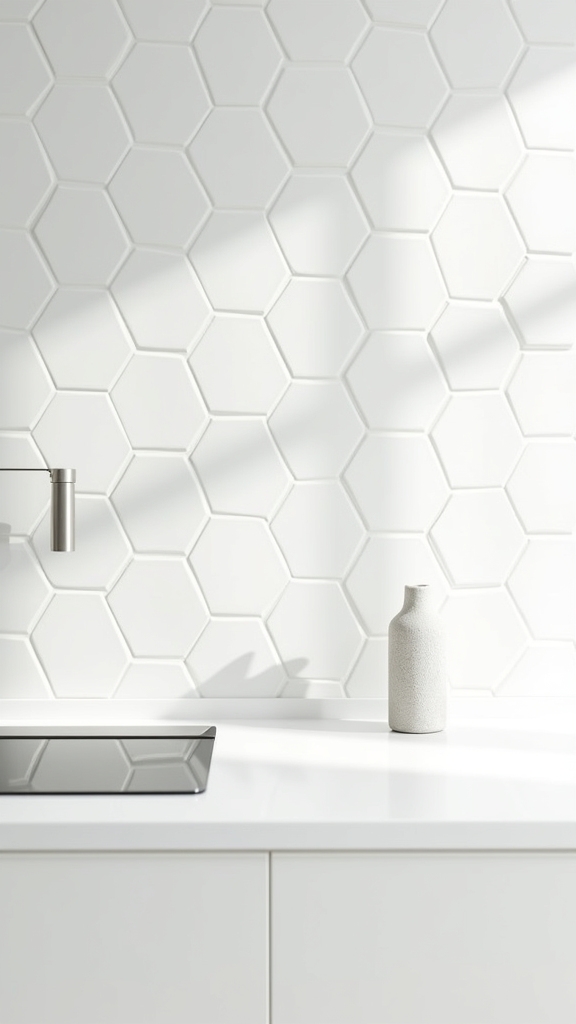
Geometry takes center stage with contemporary hexagon tiles, offering a striking alternative to traditional rectangular formats in modern kitchen design.
These tiles introduce visual dynamism while supporting a modern minimalist ethos, making them a favored solution for refined yet impactful spaces. Available in both glossy and matte finishes, hexagon tiles can be curated to either reflect ambient light or deliver a subdued, sophisticated surface.
Their versatile arrangement options empower designers to tailor the wall aesthetic, achieving anything from understated elegance to bold geometric statements.
- Hexagon tiles offer compatibility with a variety of materials—ceramic, porcelain, and natural stone—ensuring both durability and style.
- Their modular geometry enables creative patterns such as herringbone or stacked layouts, enhancing spatial interest.
- Seamless pairing with both neutral and bold kitchen elements supports cohesive, modern minimalist design solutions.
Timeless Marble-Effect Tiles
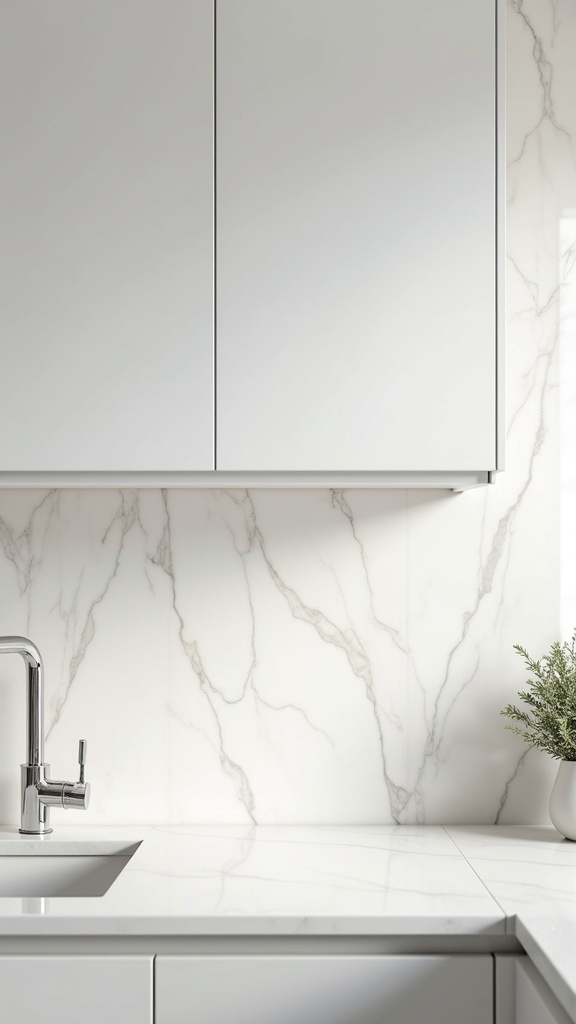
Marble-effect tiles deliver an enduring sense of luxury to kitchen walls, replicating the intricate veining and nuanced coloration of natural marble without its maintenance demands.
These porcelain tiles provide a compelling solution for those seeking sophistication and resilience in busy culinary spaces. Available in both glossy and matte finishes, marble-effect tiles allow for tailored ambiance—whether aiming for a reflective, luminous backdrop or a softer, understated surface.
Marble-effect porcelain tiles offer sophisticated style and durable performance, with glossy or matte finishes to perfectly suit your kitchen’s ambiance.
Their advanced stain and moisture resistance guarantees long-term visual integrity, surpassing the practical limitations of real marble. With their versatile design, marble-effect tiles seamlessly complement a variety of aesthetics, from classic to modern.
When paired with a white kitchen floor, these tiles create a cohesive, airy environment that accentuates timeless elegance and enduring appeal.
Mini Mosaic Tiles for Playful Texture
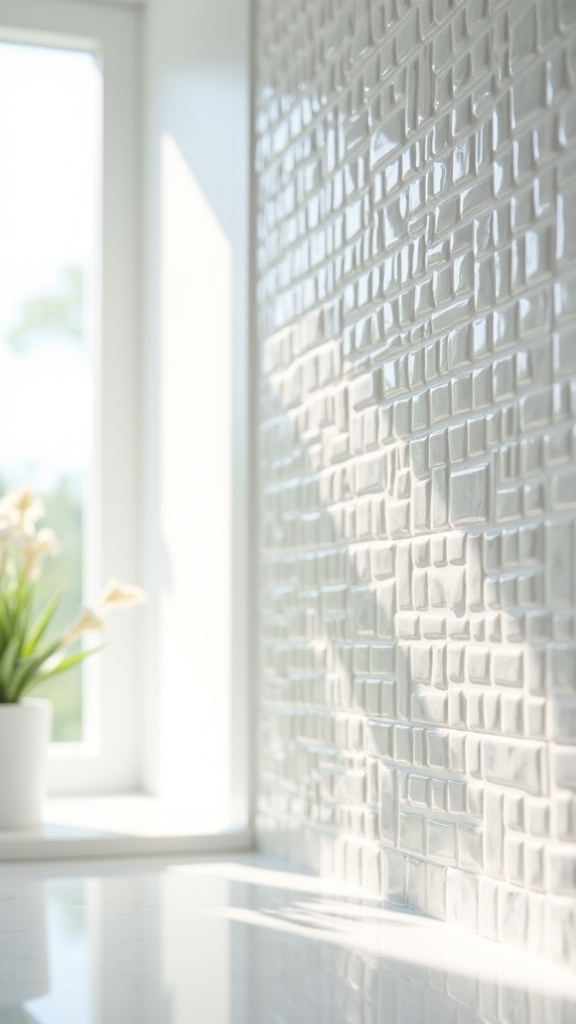
Mini mosaic tiles introduce dynamic visual interest to white kitchen walls through their intricate patterns and playful geometry.
Designers can customize the aesthetic with creative material selections, such as glass or stone, to achieve a tailored look.
Their versatility accommodates varied placements, from feature backsplashes to accent niches, complementing both modern and traditional kitchen schemes.
Adding Visual Interest
A myriad of materials—ranging from glass and marble to ceramic—empowers designers to craft dynamic white kitchen walls through the use of mini mosaic tiles.
The inherent versatility of mini mosaic tiles introduces layers of visual interest, allowing for nuanced interplay between texture, pattern, and reflectivity. Their diminutive scale is particularly effective in accent applications, yielding an artistic focal point without sacrificing the timeless simplicity of white tiles.
Key design benefits include:
- Enhanced light diffusion: The irregular surfaces of mini mosaic tiles amplify natural and artificial light, creating a luminous, airy environment.
- Playful pattern integration: Subtle geometric or organic motifs can be achieved, adding personality while maintaining a restrained aesthetic.
- Seamless pairing: Mini mosaics effortlessly complement larger white tiles or neutral cabinetry, ensuring a balanced, cohesive kitchen palette.
Creative Material Choices
Texture emerges as a defining element when incorporating mini mosaic tiles into white kitchen wall designs. These tiles infuse playful texture and visual intrigue, setting them apart from the uniformity of plain white tiles.
Available in a diverse array of materials—such as glass, marble, and ceramic—mini mosaic tiles allow for nuanced selection of finishes that harmonize with surrounding kitchen elements. Their diminutive scale supports intricate arrangements, empowering designers to craft distinctive patterns or expressive compositions.
This adaptability enables the creation of compelling focal points, like backsplashes or accent walls, that offer a sophisticated counterpoint to expanses of larger white tiles. Mini mosaic tiles deliver both modernity and timelessness, accommodating evolving design sensibilities while maintaining a clean, enduring aesthetic within white kitchen environments.
Versatile Placement Options
Countless design possibilities emerge when integrating mini mosaic tiles into white kitchen walls, thanks to their adaptable scale and diverse material options.
The versatile placement options afforded by mini mosaic tiles enable homeowners and designers to craft highly customized interiors, blending playful texture with timeless palette. These tiles excel at introducing depth and character without overpowering the minimalist appeal of white kitchens.
Whether deployed as an accent or a focal feature, their diminutive size supports intricate layouts, dynamic patterns, and creative color pairings.
- Mini mosaic tiles can be installed as a striking splashback, adding tactile interest behind sinks and stovetops.
- They serve as enchanting feature walls, breaking visual monotony while maintaining a cohesive aesthetic.
- Applied selectively, mini mosaic tiles inject subtle contrast within expansive fields of classic white tiling.
Characterful Penny Tiles for a Retro Touch
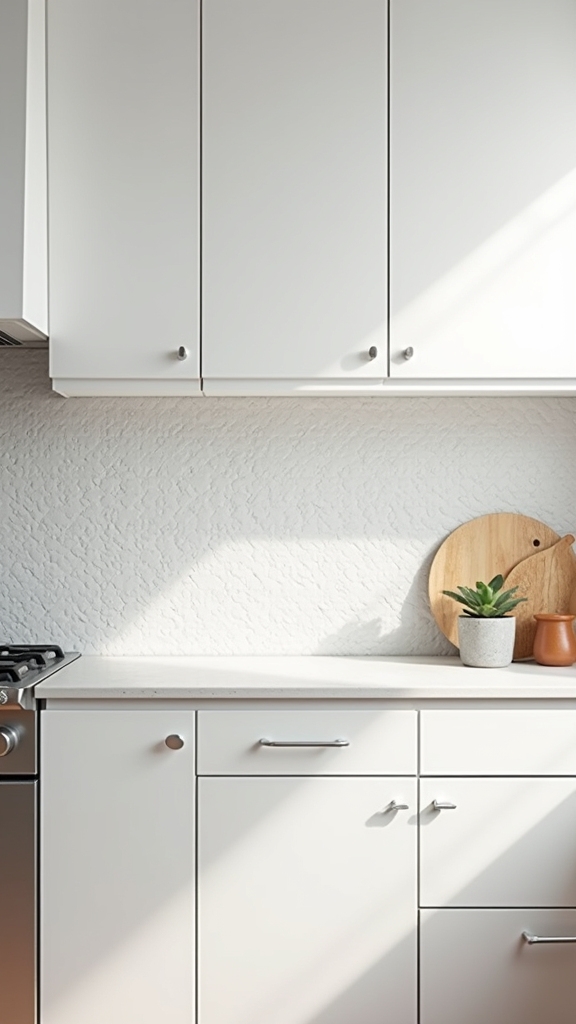
While many kitchen wall tile options lean toward modern minimalism, penny tiles offer a distinct retro charm that instantly enlivens the space.
Characterized by their small, circular form, white tiles in the penny style introduce an engaging visual texture that both brightens and softens the kitchen environment. Their inherent versatility allows designers to experiment with layout—ranging from uniform rows to creative mosaic patterns—offering subtle nods to mid-century design sensibilities.
Available in ceramic, porcelain, or glass, penny tiles adapt seamlessly to various aesthetics while remaining easy to maintain. Their rounded edges mitigate harsh lines and add a welcoming warmth, making them an ideal backsplash solution.
This tactile, light-reflective surface guarantees a timeless appeal, perfectly balancing character and cleanliness in contemporary kitchen design.
Fan-Shaped Tiles for Unique Appeal

Moving beyond the retro charm of penny tiles, fan-shaped tiles introduce an enhanced sense of artistry to white kitchen walls. Their distinct geometry captures attention, transforming an ordinary backsplash into an architectural statement.
The interplay of curved lines and crisp white surfaces produces a visually dynamic backdrop, perfect for both minimalist and maximalist interiors. Fan-shaped tiles also provide remarkable flexibility in layout, supporting a range of creative applications that improve the overall ambiance.
- The soft, scalloped edges of fan-shaped tiles impart warmth and approachability, counterbalancing the starkness of a white kitchen while retaining a contemporary edge.
- Multiple arrangement options—such as overlapping fans or staggered rows—enable personalized, one-of-a-kind designs.
- Materials and finishes vary from glossy porcelain to matte ceramics, ensuring compatibility with both classic and modern kitchen aesthetics.
White Tiles With Colored Grout Accents
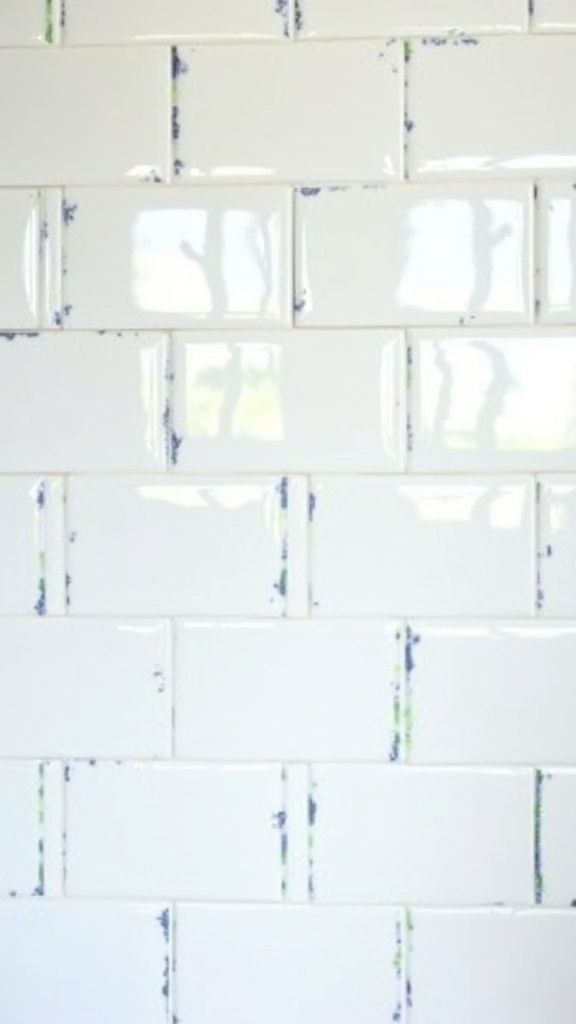
Incorporating colored grout with white tiles redefines the visual character of a kitchen, transforming standard surfaces into dynamic design statements.
This approach enables tailored expression, as grout hues can be chosen to coordinate with cabinetry, hardware, or appliances for a cohesive, personalized effect.
Strategically selected grout colors also serve to accentuate tile patterns, imparting depth and elevating the overall sophistication of the space.
Transforming Tiles With Grout
Although white kitchen wall tiles are often chosen for their timeless versatility, the selection of grout color can serve as a transformative design element that enhances the entire space.
Expert designers understand that grout color is not merely a functional consideration but a critical aesthetic tool. For instance, black grout with white tiles delivers a bold, industrial contrast, while custom hues can subtly echo cabinetry or hardware.
Grout can also manipulate visual proportions—darker tones make tiles appear more substantial, whereas lighter grout sharpens the crispness of tile patterns.
To maximize both style and utility:
- Colored grout accentuates herringbone or mosaic installations, amplifying pattern visibility.
- Coordinated grout colors unify disparate kitchen elements for a cohesive look.
- Darker grout options offer superior stain concealment, optimizing long-term maintenance.
Personalizing Kitchen Design
Beyond the functional influence of grout selection, the interplay between white tiles and colored grout introduces a powerful avenue for personal expression in kitchen design.
Opting for white tiles with black grout delivers a visually arresting, industrial-inspired effect that emphasizes geometric patterns and crisp lines. Conversely, custom-colored grout can be meticulously curated to echo cabinetry tones or accent features, ensuring a harmonious, tailored environment.
This nuanced approach enhances the inherent simplicity of white tiles by adding dimensionality, depth, and distinct character without detracting from their timeless appeal. Strategic use of colored grout also allows designers to manipulate visual scale—darker hues create bolder demarcations, while lighter options foster a seamless, expansive feel.
Ultimately, these design decisions empower homeowners to infuse individuality and cohesion into their kitchen spaces.
Simple Square Tiles for Minimalist Design
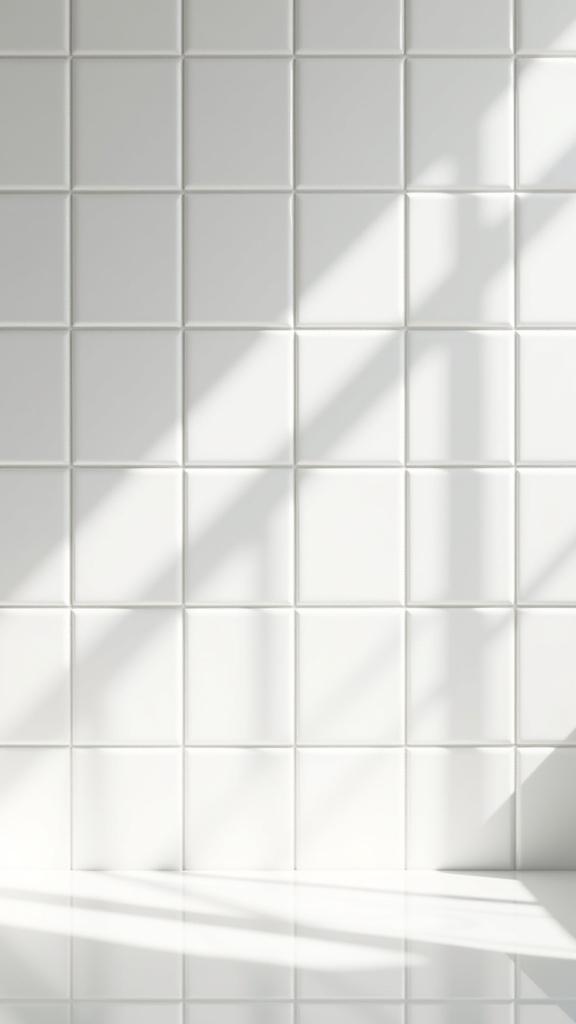
When seeking a refined and understated aesthetic, simple white square tiles deliver a minimalist foundation that seamlessly adapts to a range of kitchen styles. The crisp geometry and clean lines inherent in simple square tiles are ideal for achieving a minimalist design, offering both visual serenity and functional versatility.
Their glossy finish amplifies natural and artificial light, resulting in an open, airy ambiance—particularly advantageous in compact spaces. The uniformity of these tiles fosters cohesion and clarity, ensuring a tranquil backdrop for statement cabinetry or bold appliances.
For added stylistic impact, designers recommend:
- Utilizing larger-format square tiles for a contemporary, expansive feel
- Arranging tiles in grid or diamond patterns to introduce subtle visual interest
- Pairing with contrasting grout to define the minimalist geometry without sacrificing simplicity
Incorporating reflective surfaces such as these tiles can further enhance the brightness and airy atmosphere in the kitchen.
Rustic White Tiles for a Cozy Atmosphere
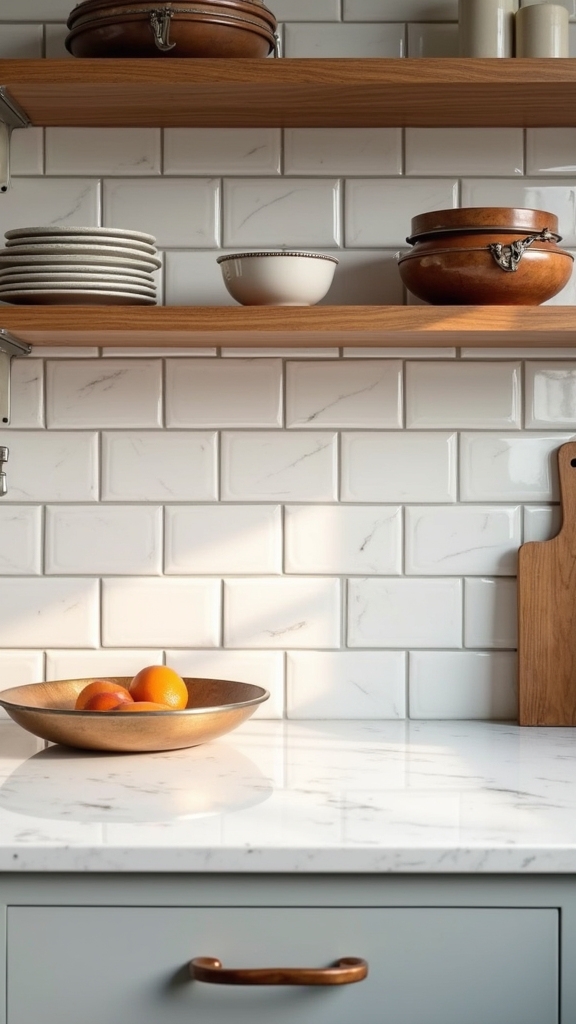
Texture becomes a defining element in the pursuit of a cozy kitchen, with rustic white tiles offering a tactile and visual warmth that amplifies the overall atmosphere. Collections like Kennet and Ullswater exemplify how unique, hand-hewn finishes and subtle imperfections can evoke a sense of authenticity. Rustic white tiles, especially those with warm undertones such as beige or cream, pair harmoniously with natural wood cabinetry to reinforce a welcoming, country-style aesthetic. Herringbone or other dynamic layouts further introduce visual interest while maintaining timeless appeal. To enhance the cozy atmosphere, designers often recommend complementing these tiles with soft, muted colors or earthy-toned accessories. This strategic pairing guarantees that rustic white tiles become the focal point for a kitchen that feels both serene and inviting. Adding reclaimed wood worktops to the design further accentuates the rustic-modern aesthetic, promoting sustainability and adding unique character to the space.
| Design Element | Effect on Atmosphere |
|---|---|
| Warm undertones | Enhances coziness |
| Herringbone pattern | Adds visual intrigue |
| Wood cabinetry pairing | Increases warmth |
| Earthy accessories | Deepens inviting feel |
Floor-to-Ceiling White Tile Feature Walls
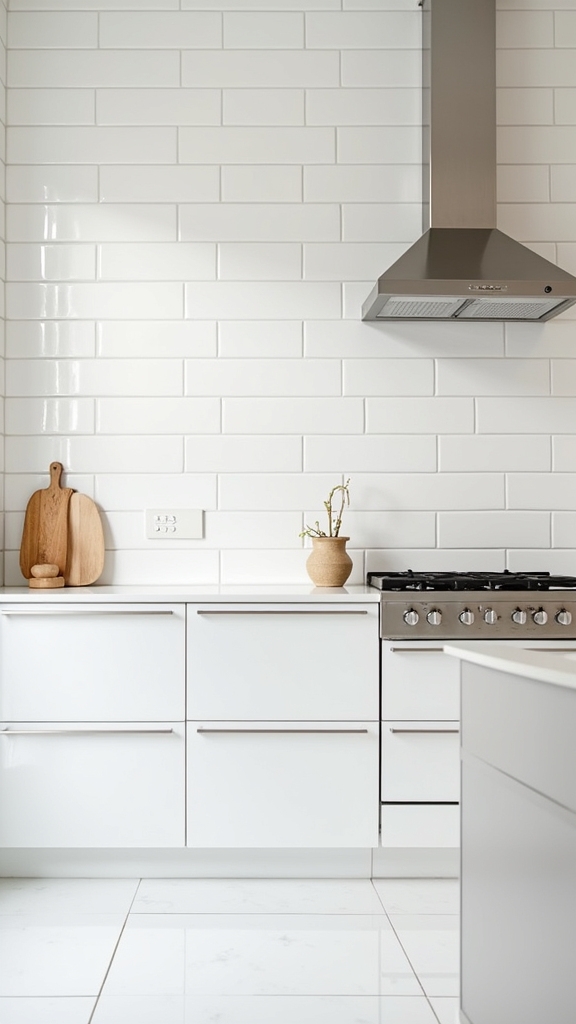
A floor-to-ceiling white tile feature wall serves as a transformative design solution, instantly boosting both the perceived height and luminosity of a kitchen.
By extending white feature walls from the countertop to the ceiling, designers achieve a seamless vertical expanse that visually enlarges the space. Glossy finishes on floor-to-ceiling white tile further enhance light reflection, optimizing brightness and fostering an airy, open atmosphere.
Tile layout selection—such as herringbone or stacked arrangements—introduces subtle movement and texture, offering a sophisticated yet timeless backdrop.
To uplift this approach, consider:
- Herringbone or stacked white tile layouts for dynamic visual rhythm.
- Gloss finish tiles to maximize light diffusion and spatial clarity.
- White tiles with delicate patterns or textures for understated elegance.
This solution merges functionality with enduring style.
Pairing White Tiles With Neutral Cabinetry
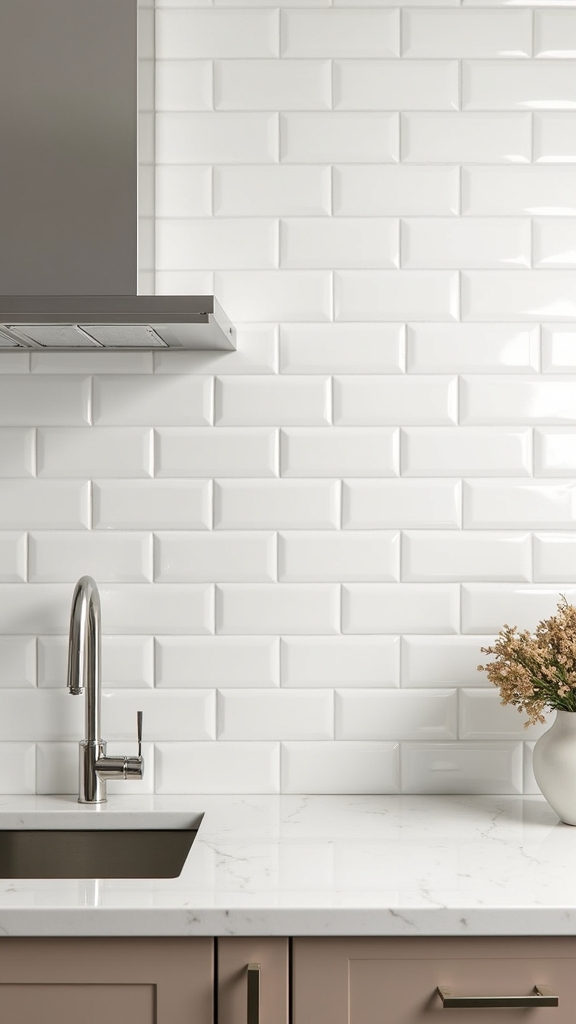
How can designers craft a kitchen environment that feels both refined and inviting? The answer often lies in the strategic pairing of white tiles with neutral cabinetry.
Selecting cream, pale sage, or natural wood cabinetry alongside crisp white tiles creates a serene, luminous atmosphere that underscores timeless design principles. This approach amplifies natural light and produces visual harmony, letting the cabinetry become a focal point while the white tiles recede elegantly into the background. Layering greys with white cabinetry enhances aesthetic depth in a kitchen, adding nuanced gradations that enrich visual interest while preserving airiness.
Opting for off-white tiles with wood cabinetry introduces warmth and a tactile sensibility, lending a comforting cottage-inspired aesthetic. For a contemporary twist, white herringbone tiles paired with wooden cabinets evoke modern sophistication.
Extending white tiles across walls and floors maintains balance and cohesion, ensuring a clean, enduring kitchen aesthetic.
Frequently Asked Questions
What Is the Most Timeless Kitchen Tile?
When considering the most timeless kitchen tile, experts often recommend classic tile designs like white subway tiles. These durable tile materials offer enduring appeal, adaptability to diverse aesthetics, and low maintenance, ensuring both functional longevity and unfading elegance.
What Style of Tile Is Timeless?
When considering timeless tile styles, design professionals frequently recommend classic subway tiles for their universal appeal and adaptability. Mosaic patterns, especially in neutral palettes, also endure, offering intricate detailing that complements diverse interiors while maintaining long-term stylistic relevance.
What Is the Best Kitchen Tile to Keep Clean?
When considering the best kitchen tile to keep clean, experts recommend glossy ceramic or porcelain tile materials, as their nonporous surfaces facilitate straightforward cleaning methods. Pairing these with stain-resistant grout further optimizes long-term maintenance and hygiene.
What Tiles Go Well With a White Kitchen?
Selecting tiles for a white kitchen, experts recommend ceramic options for durability and easy maintenance. Contrasting colors, such as dark hues or colored grout, and textured or patterned surfaces, provide visual interest while preserving a sophisticated, cohesive aesthetic.
Conclusion
Incorporating white kitchen wall tiles remains a timeless design strategy, offering both versatility and enduring appeal. Whether opting for classic subway layouts, herringbone patterns, or matte finishes, each style provides a refined backdrop adaptable to evolving trends. Strategic use of grout color and tile orientation further personalizes the aesthetic, ensuring the kitchen feels both fresh and sophisticated. Ultimately, white tiles are a proven, solution-oriented choice for achieving a clean, cohesive, and stylish culinary space.
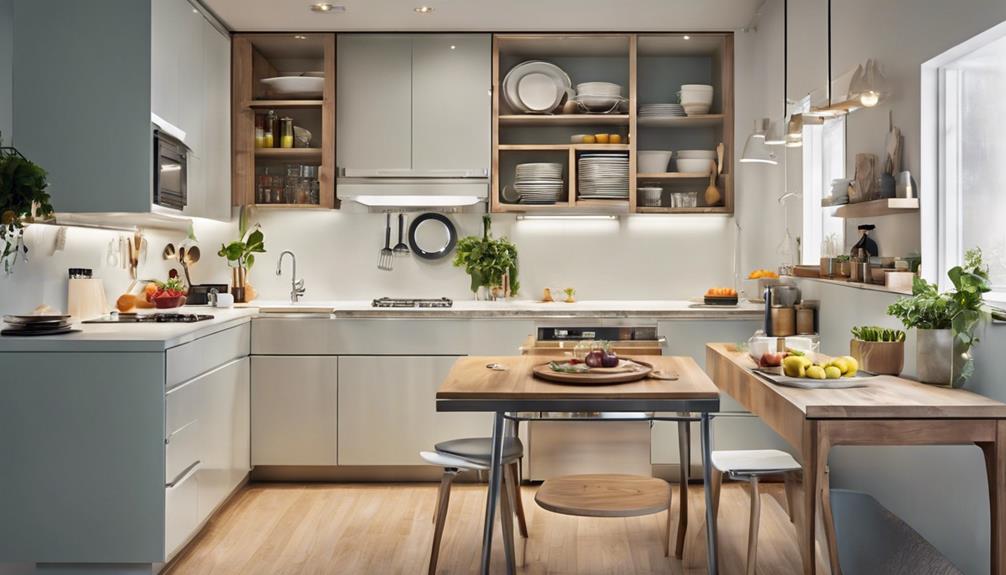
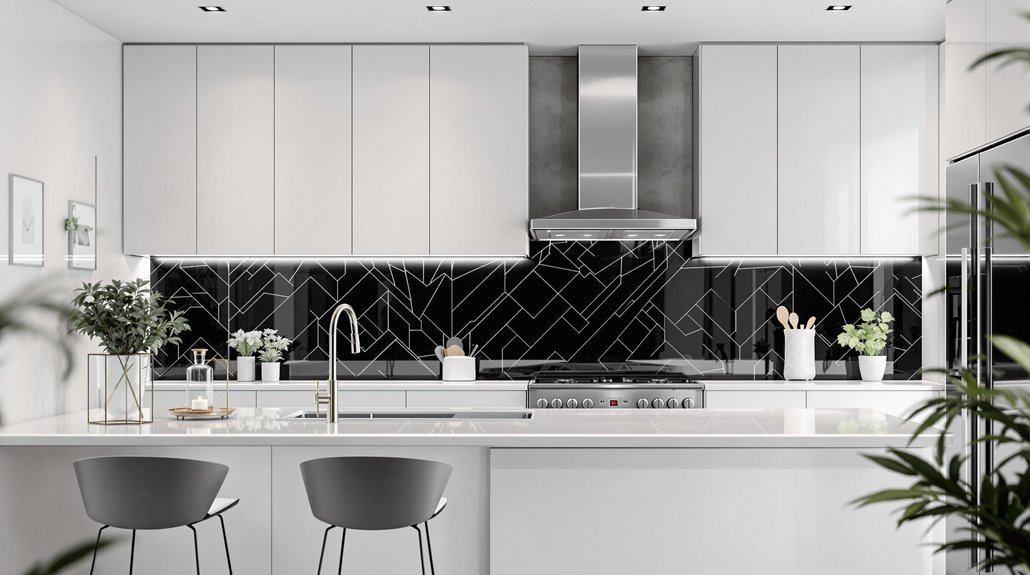

Leave a Reply